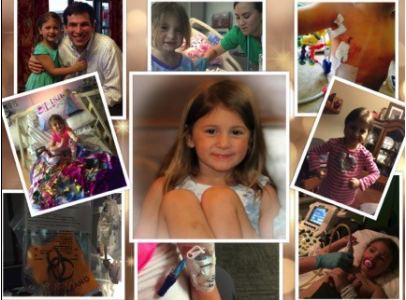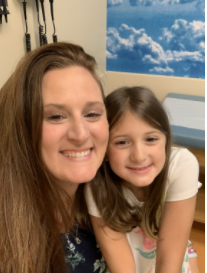Castleman disease: "I am dedicating my life to help find a cure for my daughter while also advocating for all patients"
Published 18 Feb 2022 • By Charlotte Avril
Mileva, mother of a little girl living with Castleman disease and member of the CDCN, tells us her story: her daily life in the fight against the disease, the support she provides to patients and their loved ones, and her role within the CDCN!
Discover her story below!

Hi Mileva, can you tell us a little bit about yourself?
My name is Mileva Repasky and I am the Chief Patient and Development Officer with the CDCN (Castleman Disease Collaborative Network). I am a member of our leadership team and have worked alongside Dr. David Fajgenbaum for the last 7 years. I initially became involved with our organization as a volunteer when my daughter Katie was diagnosed with Castleman disease as a toddler.
Photo courtesy of Mileva Repasky
What are your daily missions and activities at the CDCN?
A typical week for me consists of 30+ hours addressing the needs of our patients and their families, engaging with various stakeholders in our community, and working alongside our team on various projects to drive forward our life-saving research. For example, we have a partnership with the Chan Zuckerberg Initiative to advance drug repurposing for rare diseases. I am serving as the Patient Engagement Lead to continue to ensure that the voice of our patients is at the centre of all we do while we work to share the lessons we have learned while navigating the repurposing landscape with other rare disease organizations by creating a guide for others to follow.
Can you tell us more about how the CDCN is collaborating with other rare disease organizations or therapeutic areas?
The CDCN partners with the The Center for Cytokine Storm Treatment & Laboratory (CSTL) at the Perelman School of Medicine at the University of Pennsylvania. The CSTL’s mission is to conduct ground-breaking translational research on Castleman disease, COVID-19, and other cytokine storms to discover novel diagnostic biomarkers and therapeutics, identify optimal treatment approaches, and provide world-class patient care. The CSTL pursues its mission through basic & translational research, clinical research, clinical trials, and multi-disciplinary patient care. While there is a focus on CD, the learnings about the immune system from this work will transcend other conditions.
In light of the COVID-19 pandemic, our team also started an effort to use our expertise and experience in drug repurposing to help those affected by coronavirus. The CDCN launched the CORONA Project in March 2020 to identify and track all treatments reported to be used for COVID-19 in an open-source data repository. The CORONA team has reviewed 29,353 papers and extracted 2,399 papers on 590 treatments administered to 437,936 patients with COVID-19, and in continuing to help researchers to prioritize treatments for clinical trials and inform patient care.
From your personal perspective, what is or are the most important achievement(s) you've contributed to during your experience with the CDCN that you can share with us?
This is a difficult question as there have been so many moments in my career that I am proud of, but all revolve around our patients and the success of our team.
A few of my favourite are attending the first Patient and Loved One Summit (after I was in this role) and being able to hug all the people I spent the year talking to and helping, successfully engaging a group of our patients to fundraise enough money to fund a study, working alongside the Chan Zuckerberg Initiative to expand our collaborative approach to other rare disease and also our new project on drug repurposing, and also being a part of the CORONA project and doing my part to aide in the fight against COVID when the pandemic hit!
One of my proudest patient-related moments involved working alongside our team to help a paediatric family whose child was battling idiopathic multicentric Castleman disease with TAFRO get a definitive diagnosis and treatment plan. Having the ability to support them in the hospital and provide resources to them within hours of hearing about this case was so special to me. I remember this moment when I walked into his hospital room and hugged his parents, I could feel their devastation and it just was a very real reminder of why I am doing this!! He is now doing amazing and on the same treatment that my daughter Katie is on, sirolimus!
What is your personal involvement with patients?
My personal involvement with patients takes the form of answering emails and phone calls when patients and loved ones reach out to the CDCN for help. I’m always so glad that they found us and are now connected with a group that can make a difference to help their situation. Sometimes it’s about finding the closest specialist/physician to a patient, gaining insight on published literature on treatments and diagnosis to share with their doctors, and connecting for emotional support.
What personal benefits do you get from this experience?
When my daughter Katie was around 18 months old, we started down a road of so many unknowns to find a diagnosis for what she was battling. We received the diagnosis of Castleman disease before her second birthday. I had no idea what the road ahead would be but what I did know was that I would fight beside her to find a cure - and that led me to finding the CDCN. Over the past 8 years we have watched her endure more than any child ever should, all while feeling like we are in the dark with so many questions and so few answers. With the diagnosis I knew that I had to dedicate my life to doing my part, which is helping patients and their loved ones who are going down the same road we were on. I will continue to dedicate my life to support our patients, their loved ones, and fight alongside them and our amazing team. The personal reward in this is that I am dedicating my life to helping find a cure for my daughter while simultaneously advocating for all our patients.

What do you hope to achieve in the long-term within the CDCN?
My role is important to our organization as patients are truly at the heart of everything we do. The patient perspective is a vital piece of the puzzle of Castleman disease. This role allows me to advocate the needs of our patients while also facilitating the needs of the organization allowing our patients to have a voice in all that we do. I hope that I can continue to advocate and be a voice for our patients and play a vital role in helping all our patients find treatments that work for them and live full and healthy lives.
What advice would you give to someone newly diagnosed with Castleman disease?
I know how scary this diagnosis can be and how the unknowns of this disease can feel crippling. But you are not alone! Our organization is dedicated to advancing research and treatments for CD and supporting patients and loved ones throughout their battle. I am here to support you and your family anyway that I can. Each and every one of our patients has a missing piece to the puzzle that can unlock the cure, and together we can take this disease down!
How do you think social media or patient platforms can help CD patients?
Social media and other outlets like Carenity and CDCN Connect give patients a place to connect, support each other, learn more about their disease from others going through similar things, but also can be used as a resource to help spread awareness of this disease.
Give it a "like" and share your thoughts and questions with the community in the comments below!
Take care!
Comments
You will also like

Testimonial - Castleman disease: "I was relieved to finally find out what I'd been suffering with!".
8 Jun 2022


 Facebook
Facebook Twitter
Twitter

